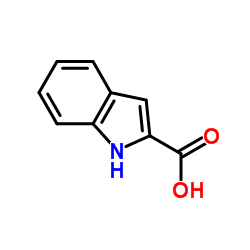Indole-2-carboxylic acid

Indole-2-carboxylic acid structure
|
Common Name | Indole-2-carboxylic acid | ||
|---|---|---|---|---|
| CAS Number | 1477-50-5 | Molecular Weight | 161.157 | |
| Density | 1.4±0.1 g/cm3 | Boiling Point | 419.6±18.0 °C at 760 mmHg | |
| Molecular Formula | C9H7NO2 | Melting Point | 202-206 °C(lit.) | |
| MSDS | USA | Flash Point | 207.6±21.2 °C | |
|
Molecular modifications on carboxylic acid derivatives as potent histone deacetylase inhibitors: Activity and docking studies.
Bioorg. Med. Chem. 17 , 5219-28, (2009) In the light of known HDAC inhibitors, 33 carboxylic acid derivatives were tested to understand the structural requirements for HDAC inhibition activity. Several modifications were applied to develop the structure-activity relationships of carboxylic acid HDA... |
|
|
In vitro and in vivo assessment of the antioxidant activity of melatonin and related indole derivatives.
Gen. Physiol. Biophys. 21(2) , 153-62, (2002) Effects of melatonin and some structurally related indole compounds were studied by in vitro methods such as (i) an inhibition of the hyaluronic acid degradation and (ii) a standard lipid peroxidation assay. In vivo approach was based on the alloxan model of ... |
|
|
Protonated carbonic acid and reactive intermediates in the acidic decarboxylation of indolecarboxylic acids.
J. Org. Chem. 77(15) , 6505-9, (2012) Elucidation of the mechanism for decarboxylation of indolecarboxylic acids over a wide range of solution acidity reveals the importance of protonated carbonic acid (PCA) as a reaction intermediate. In concentrated acid, the initial addition of water to the ca... |
|
|
Formation of indigo and related compounds from indolecarboxylic acids by aromatic acid-degrading bacteria: chromogenic reactions for cloning genes encoding dioxygenases that act on aromatic acids.
J. Bacteriol. 177(23) , 6983-8, (1995) The p-cumate-degrading strain Pseudomonas putida F1 and the m- and p-toluate-degrading strain P. putida mt-2 transform indole-2-carboxylate and indole-3-carboxylate to colored products identified here as indigo, indirubin, and isatin. A mechanism by which the... |
|
|
Assembly of indole-2-carboxylic acid esters through a ligand-free copper-catalysed cascade process.
Chem. Commun. (Camb.) (48) , 7581-3, (2009) A straightforward synthesis of indole-2-carboxylic esters was developed through a ligand-free copper-catalysed condensation/coupling/deformylation cascade process from 2-halo aryl aldehydes or ketones with ethyl isocyanoacetate. The reactions proceeded well f... |
|
|
Gold(III) chloride catalyzed regioselective synthesis of pyrano[3,4-b]indol-1(9H)-ones and evaluation of anticancer potential towards human cervix adenocarcinoma.
Bioorg. Med. Chem. Lett. 21 , 4170, (2011) A highly regioselective synthesis of pyrano[3,4-b]indol-1(9H)-ones via gold(III) chloride catalyzed cycloisomerization of 3-ethynyl-indole-2-carboxylic acid was achieved in good to excellent yields. These compounds were screened for their in vitro cytotoxicit... |
|
|
Synthesis and biological activities of novel aryl indole-2-carboxylic acid analogs as PPARgamma partial agonists.
Bioorg. Med. Chem. Lett. 15(22) , 5035-8, (2005) A series of novel aryl indole-2-carboxylic acids has been identified as potent selective PPARgamma modulators. Their chemical synthesis and in vitro activities are discussed. Compound 5 was selected for in vivo testing in the db/db mouse model of type 2 diabe... |
|
|
Pacemaker activity in hydra is modulated by glycine receptor ligands.
Comp. Biochem. Physiol. A. Mol. Integr. Physiol. 138(2) , 193-202, (2004) In the mammalian central nervous system, the neurotransmitter, glycine, acts both on an inhibitory, strychnine-sensitive receptor (GlyR) and an excitatory, strychnine-insensitive site at the NMDA receptor. Here we present electrophysiological evidence that th... |
|
|
Picolinic acid and indole-2-carboxylic acid: two types of glycinergic compounds modulate motor function differentially.
Gen. Pharmacol. 28(4) , 555-60, (1997) 1. A putative agonist for the strychnine-sensitive glycine receptor picolinic acid was tested for its anticonvulsant activities in mice and muscle-relaxant activities in rats and compared with indole-2-carboxylic acid (I2CA), an antagonist for the strychnine-... |
|
|
Spectral and thermal studies of divalent transition metal with indole-2-carboxylic acid and 4-substituted hydrazinethiocarbamide.
Spectrochim. Acta. A. Mol. Biomol. Spectrosc. 65(1) , 5-10, (2006) Ternary complexes of Co(II), Ni(II) and Cu(II) with indole-2-carboxylic acid (A) and 4-substituted hydrazinethiocarbamide (L) [4-phenylhydrazinethiocarbamide (L(1)), 4-benzylhydrazinethiocarbamide (L(2)) and 4-(2-propenyl)hydrazinethiocarb-amide (L(3)) were p... |